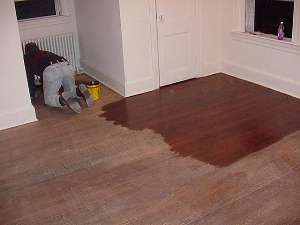|
Finishing the Floor
There are many different finishes available for the
floor. They include, but are not limited to, shellac, varnish, wax, oil and
polyurethane. For this article we will be sticking with polyurethane. It is
easy to apply and produces consistent results.
Water or Oil?
There is a fair amount of debate about what kind of
polyurethane to use: water- or oil-based. Most of it boils down to personal
preference and ease-of-use. The water-based variety smells less and dries
faster. Some people don't like the "cold" appearance of water-based
polyurethane but this can be fixed by tinting the polyurethane (some of it
comes pre-tinted). The oil-based
polyurethane looks "warmer" out of the can but smells more due
to the solvents in the base. If you are uncomfortable making a snap decision,
purchase a little can of each and apply it to a scrap. Regardless of the type
you pick, make sure that you work with adequate ventilation. Now is also the
time to pick the gloss of the final finish. Most people choose satin or
semi-gloss.
Staining and Sealing the Floor
If you want to stain the floor, now is the time to do
it. Make sure that you use a stain that is compatible with the finish you are
using. Some water-based finishes have difficulty adhering to oil-based stains
(the reverse is also true). A lot of people like to use a natural colored
stain. Whether or not you stain the floor, it needs to be sealed. You seal the
floor by "cutting" the finish you are using and applying it to the floor. If
you are using water-based poly, cut it with water. If you are using oil-based,
cut it with a solvent. In either case, check the instructions for the type and
amount of solvent to use. Apply the cut finish to the floor with a brush or
painter's pad and allow it to dry. If you are using water-based poly, you need
to lightly buff the floor with an abrasive pad (or lightly sand the floor with a
fine sand paper) to smooth the raised wood grain and remove imperfections. If
you are using oil-based polyurethane, then use fine steel wool to remove the
imperfections (DO NOT use steel wool with water-based poly, the particles left
behind may rust). After the imperfections have been removed, vacuum the floor
and wipe it down with a tack rag.
The next step is to apply at least two more coats of
polyurethane to the floor. Make sure you buff the floor with an abrasive pad
(water-based) or steel wool (oil-based) between coats to remove the small dust
bumps that appear. Be careful how much you buff the final coat as more buffing
reduces surface gloss. If you want less gloss, buff more.
|

|



